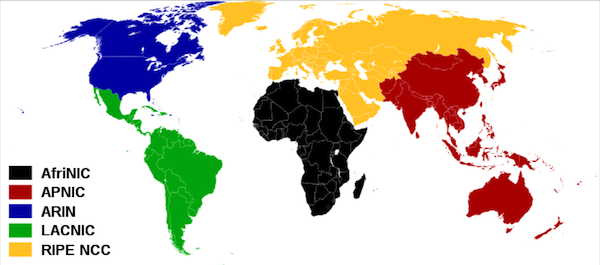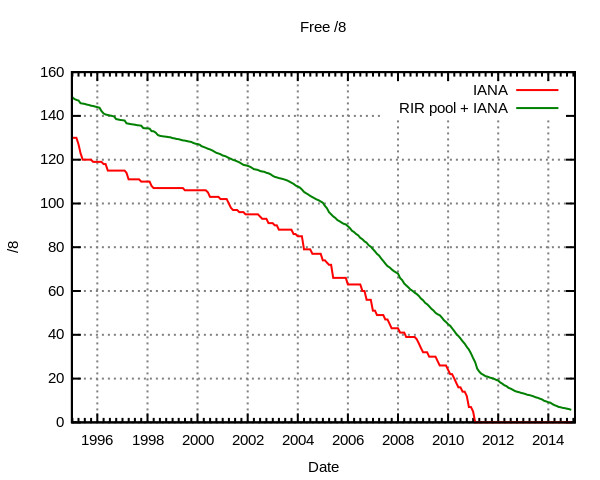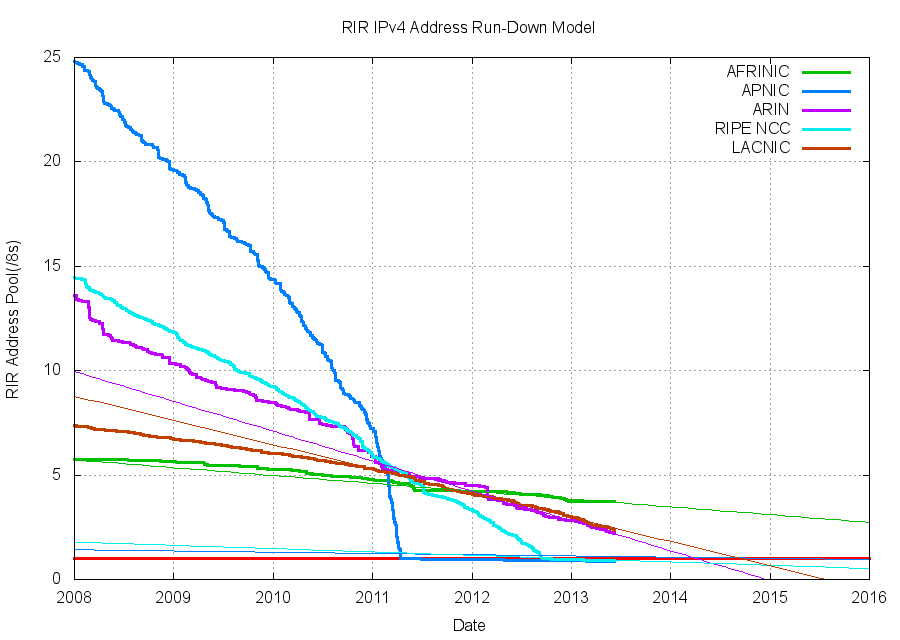IP Addresses

Address Assignment
In order to understand the IP address problem, it is helpful to have an understanding of who manages IP addresses on the internet and how these assignments flow down to the end-users. Each address must be unique and must have a published route by which packets can be directed to their intended destination. The process to accomplish this in a stable way while facilitating the growth of the internet has resulted in a distributed process involving globally shared responsibilities.
Locations on the internet are identified by IP Addresses, which are managed by the Internet Assigned Numbers Authority (IANA). IANA currently manages two types of IP addresses: IPv4 and IPv6 and allocates these to Regional Internet Registries (RIR).
The five RIRs are:
- American Registry for Internet Numbers (ARIN) for the United States, Canada, several parts of the Caribbean region, and Antarctica.
- Latin America and Caribbean Network Information Centre (LACNIC) for Latin America and parts of the Caribbean region
- Réseaux IP Européens Network Coordination Centre (RIPE) for Europe, the Middle East, and Central Asia
- Asia-Pacific Network Information Centre (APNIC) for Asia, Australia, New Zealand, and neighboring countries
- African Network Information Centre (AfriNIC) for Africa
The RIRs manage the assignment of IP addresses to their customers, including Internet Service Providers (ISPs) and end-user organizations. The RIRs participate with the Number Resource Organization (NRO) to coordinate policies and activities related to IP addresses.
The Internet Corporation for Assigned Names and Numbers (ICANN) was created in 1998 as a non-profit corporation, to conduct Internet-related functions previously performed directly on behalf of the U.S. government, including the management of the IP address spaces (IPv4 and IPv6) and for the management of the top-level domain (TLD) name space that provides the root for the Domain Name Service (DNS). ICANN's objectives include preserving the operational stability of the Internet; promoting competition; achieving broad representation of the global Internet community; and developing appropriate policies.
Address Depletion

Each RIR operates policies to manage and allocate their available address space to conserve and reallocate available addresses within their geographic areas of responsibility.
The recent exhaustion of IPv4 addresses has the consequence that there are no unassigned IPv4 addresses available for future assignment to the RIRs. When individual RIRs run through their existing IPv4 address inventories, they will be unable to assign new addresses to their ISPs or other customers, and these customers will be unable to connect additional end-users to the internet.
The IP address depletion problem was recognized in the first decade of the internet. As the internet has become pervasive in business and the home, there is an ongoing demand for new IP addresses for desktop computers, voice over IP telephones, cell phones, cameras, sensors, control systems, and many other applications. There are 232 possible IPv4 addresses (or approximately 4.3 billion). While this is a large number, the last unused addresses were allocated on 3 February 2011 by IANA to the RIRs, as is shown in the chart. The significance of this is that the IPv4 Internet has reached its maximum size as have the allocations to each of the RIRs. For the near-term, they will still have supplies of addresses to allocate to end-users and will be able to reissue unused addresses for reuse.
Impact
Although the supply of IPv4 addresses from IANA has been exhausted, most of the RIRs still have existing inventories to distribute to ISPs and end users. These include blocks of addresses that are returned for reuse when they are no longer required by their original recipients. As a result, IPv4 addresses are expected to remain available for a small number of additional years, after which the only addresses to be issued will be IPv6 addresses. The United States, Europe, and Asia-Pacific regions have already exhausted their IPv4 supplies. Latin America, and Africa will exhaust their addresses in the next few years.

Today, only a small number of ISPs offer IPv6 services, including:
- Nippon Telegraph and Telephone Corporation, NTT Communications
- Hurricane Electric (tunnel broker)
- Sonic.net
- AT&T (testing)
- Comcast (testing)
Until a larger number of ISPs offer IPv6 internet services, most end-users have limited abilities to deploy or access the new protocol, other than through a tunnel broker such as Hurricane Electric.
Interoperability
IPv6 was designed to be independent of IPv4; a system with only an IPv6 address cannot directly communicate with a system with only an IPv4 address. In order to be able to directly communicate with either other IPv4 or IPv6 systems, a system would need to have both and IPv4 and an IPv6 address, since the protocols do not interoperate. This independence allows IPv6 addresses and protocols to be used in parallel with any existing IPv4 addresses and routing.
IPv6 Business Case
While the independence between IPv6 and IPv4 was intended to facilitate the transition, it has had the opposite affect of complicating the adoption of IPv6. With the root internet services such as the Domain Name System (DNS) and the vast majority of the internet servers still hosted on IPv4, it has been impractical for new users to connect to the internet with only IPv6, since they would be isolated from most of the other internet users and be unable to access the bulk of the internet services and content. This limitation can be overcome through the use of a transition strategy such as deploying systems with both IPv6 and IPv4, but this complicates the business case for using IPv6 at all.
An additional barrier to IPv6 adoption has been the unavailability of the new protocol from the majority of ISPs. Workarounds involve changing ISPs or implementing a dual-stack strategy with tunneling IPv6 over the IPv4 WAN.
Impact
Despite its eventual inevitability and plans by the internet community and by the U.S. Government to transition to IPv6, the majority of internet users including businesses and consumers see no significant benefits to an early transition. There are no "killer applications" that require IPv6, and no internet resources that cannot be accessed using only IPv4. When the transition does occur, it is likely to happen very quickly, and will include measures to ease the impacts on the Internet overall. These are discussed later in this tutorial.







